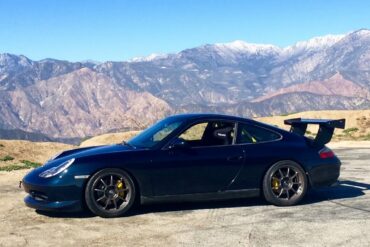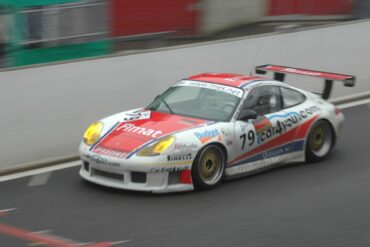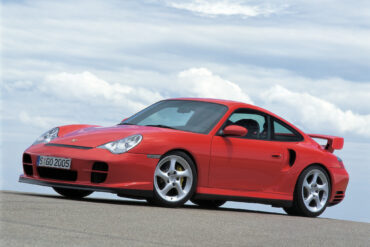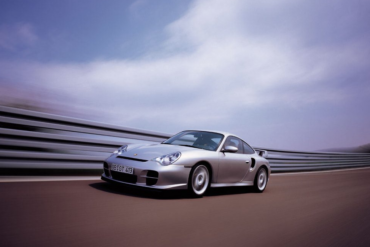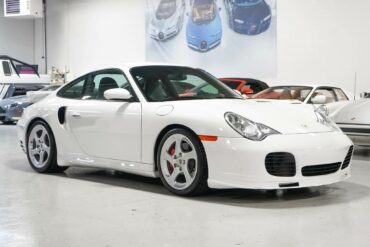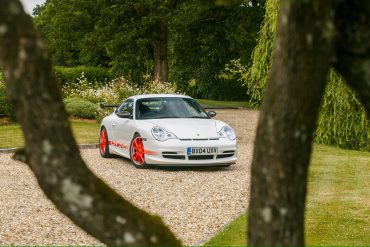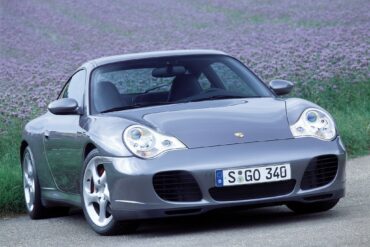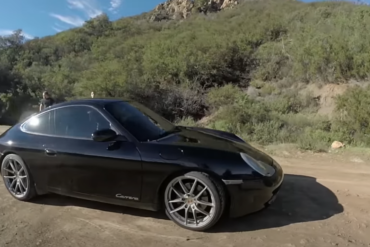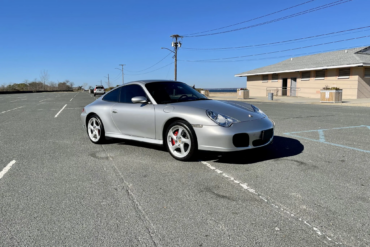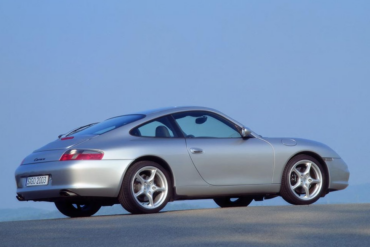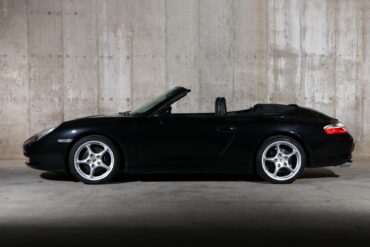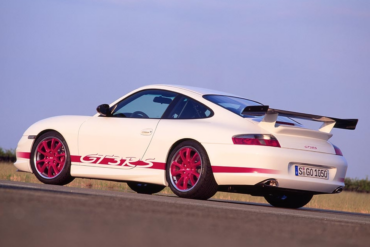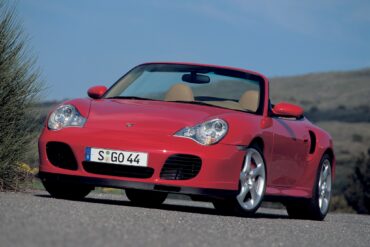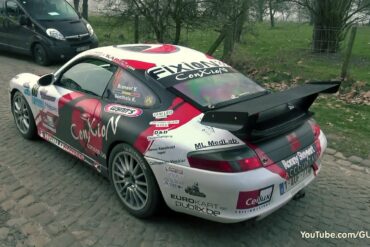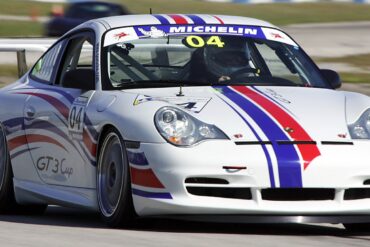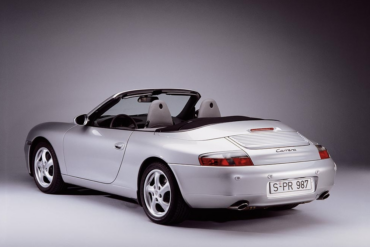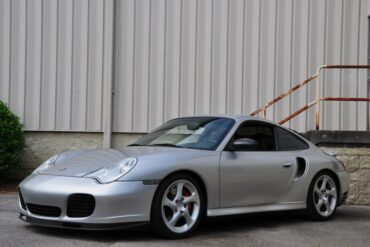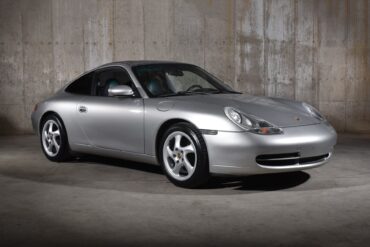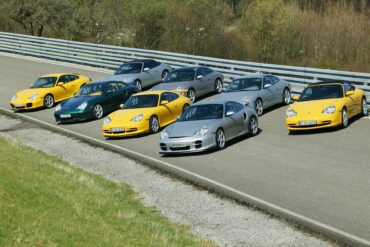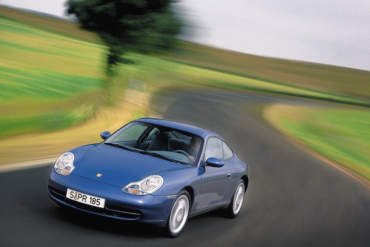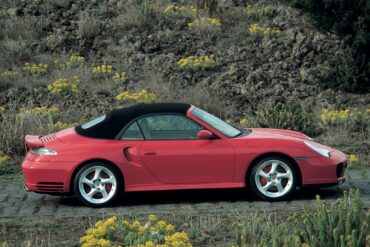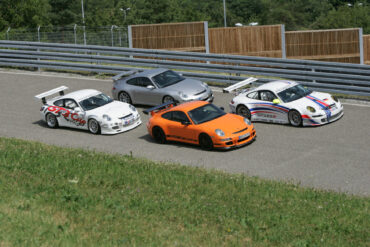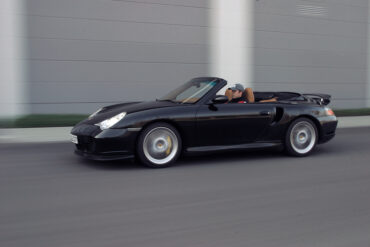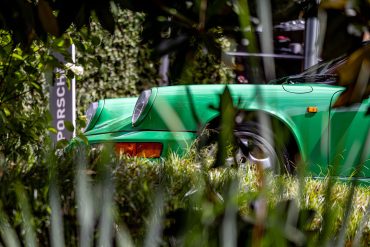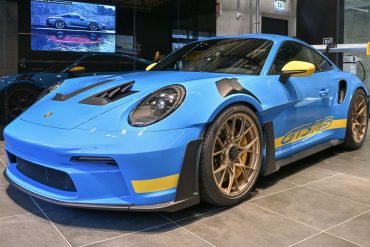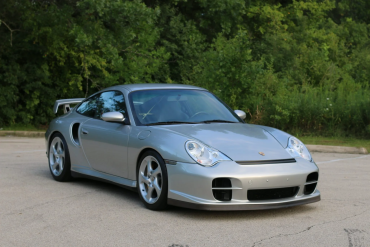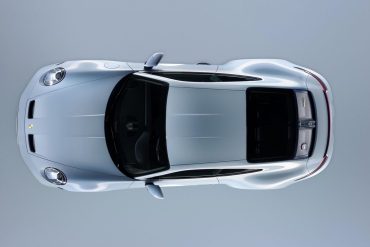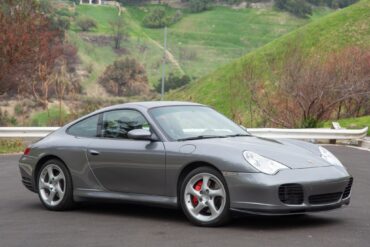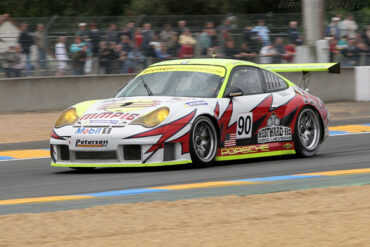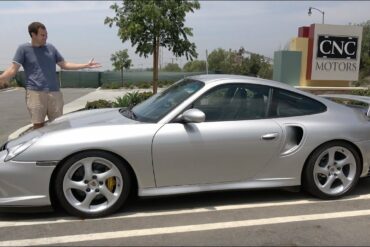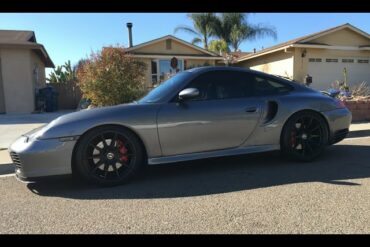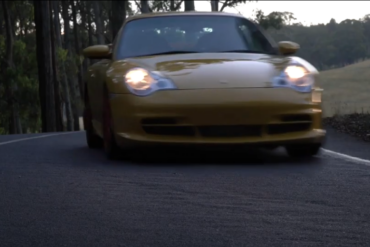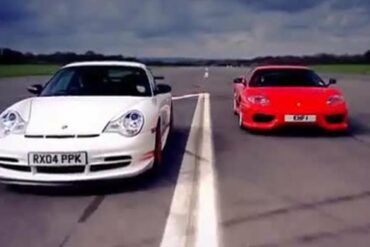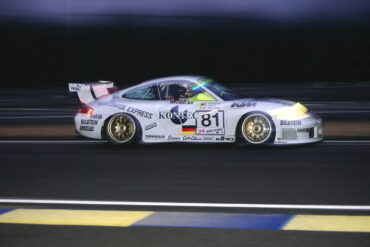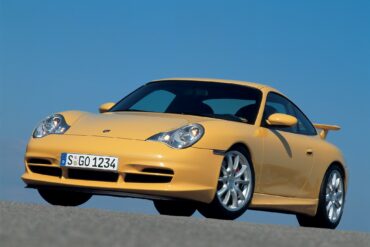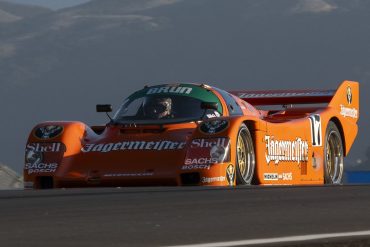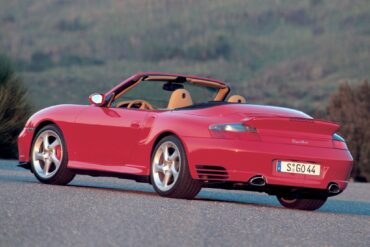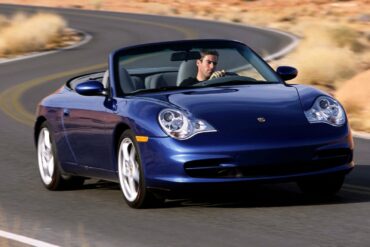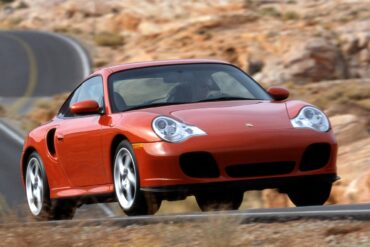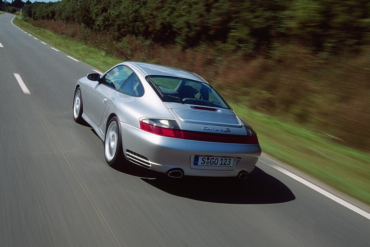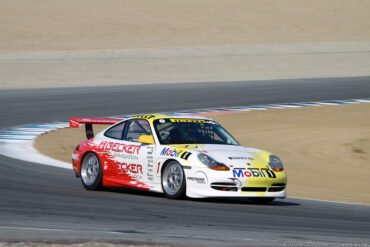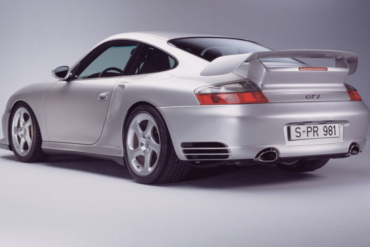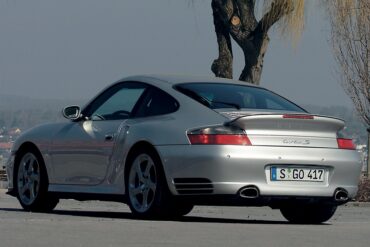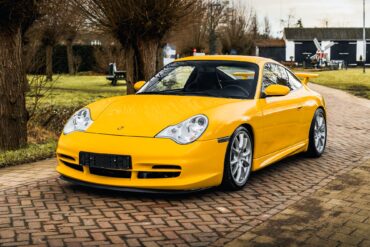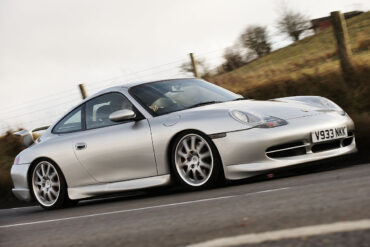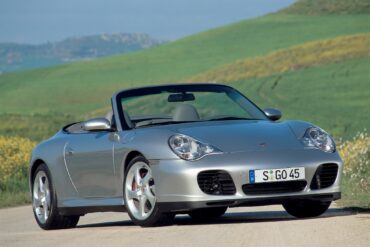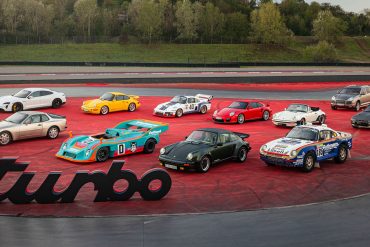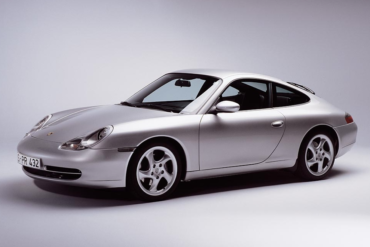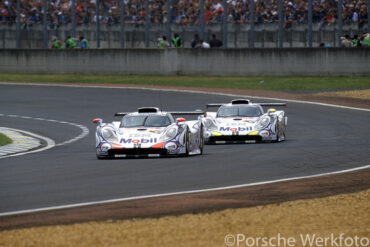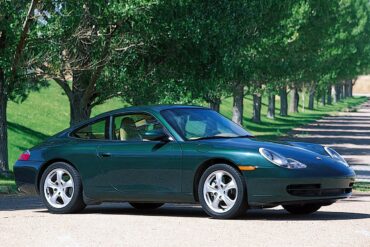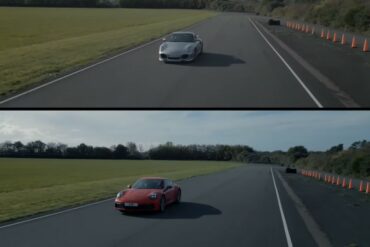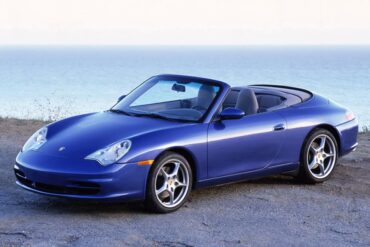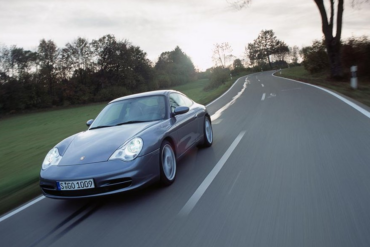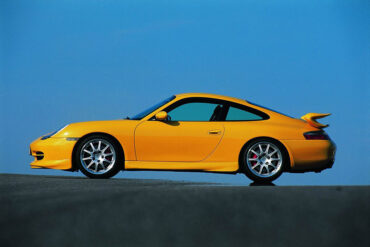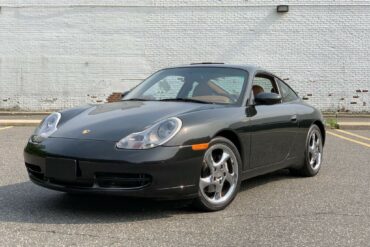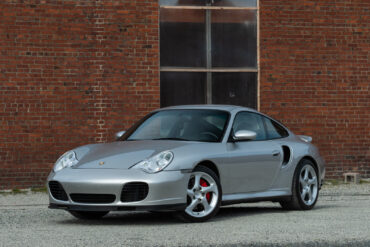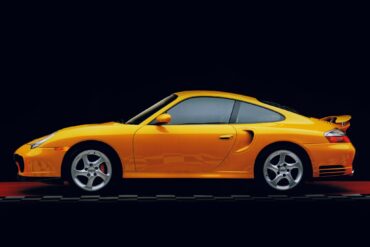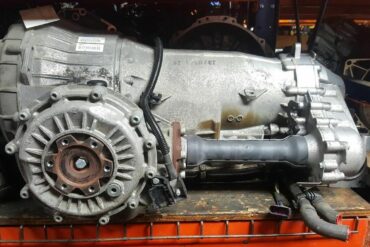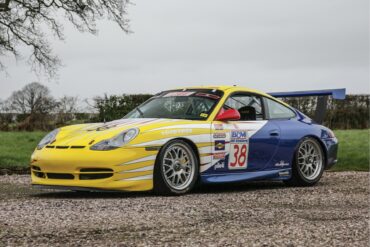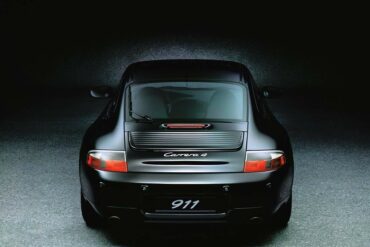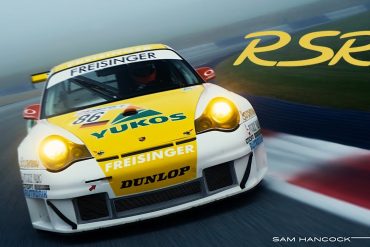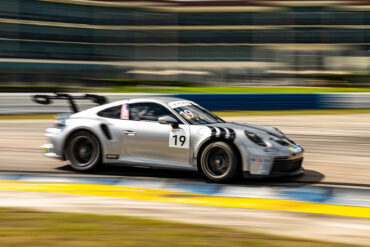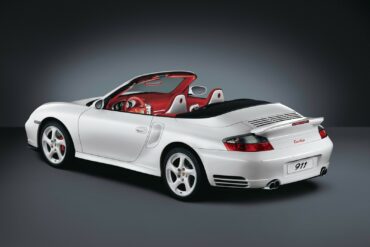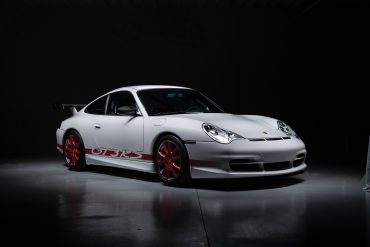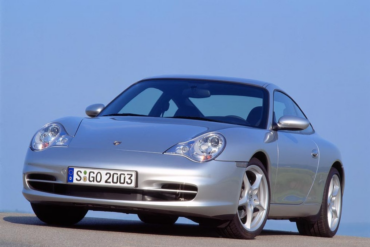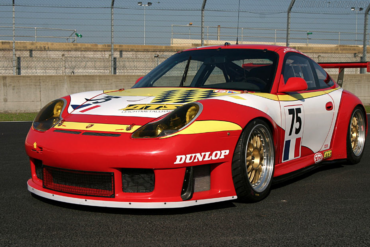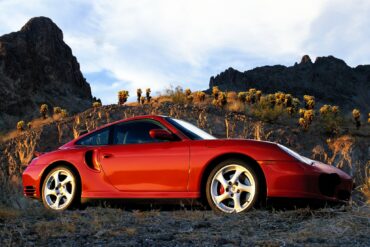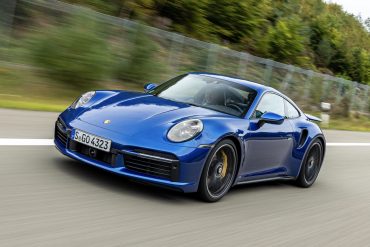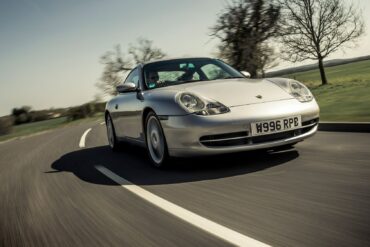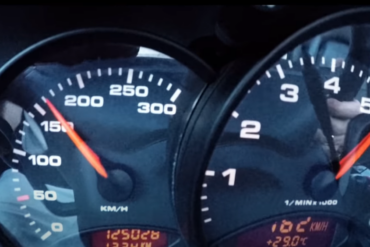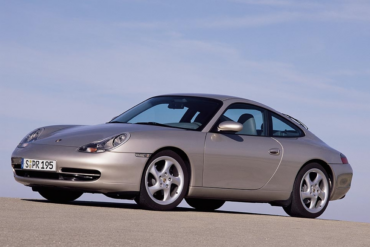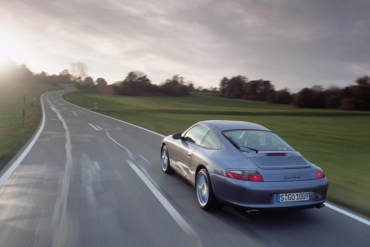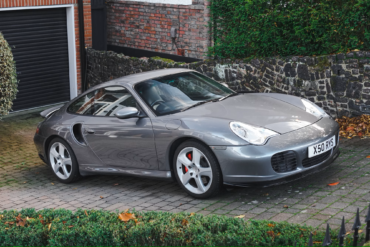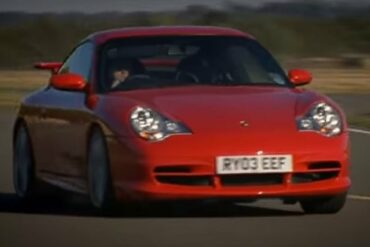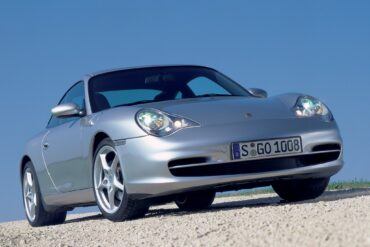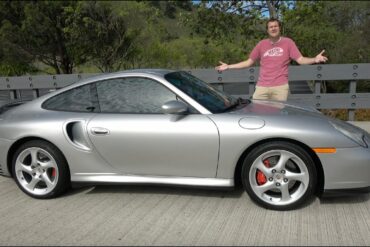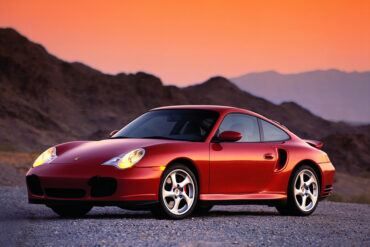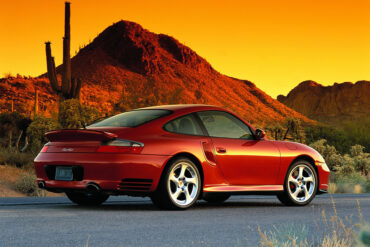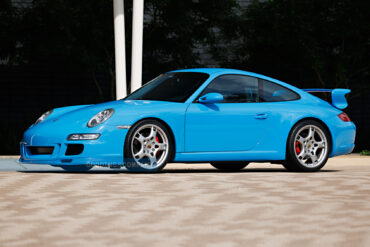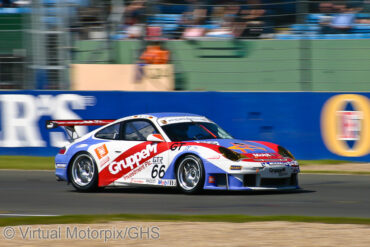The SmokingTire Takes a Tuned Porsche 996 Carrera for a Run This 2000 Porsche 996 Carrera was bought as a...
Porsche 911 (996)
The introduction of the 911 Model 996 in 1998 ushered in a whole new era for Porsche. Gone was the air-cooled flat six, replaced with an all-new, modern, water-cooled flat-six. The 996 911 was the first redesigned 911 model that didn’t carry over any significant components from it’s predecessors, significant for Porsche at the time as it was known to iterate on the original 911 formula and technology. The 996 was a big deal. It was totally revamped from the inside out. In 1998, the 996 was only offered in coupe and cabriolet versions with either rear-wheel or 4-wheel drive. The Turbo variant appeared in 2001 and came well equipped with a 3.6 L Turbocharged Flat 6 (M96/70), good for 415 bhp. All of the standard models received a minor makeover in 2002 (becoming known as the 996.2 cars), which included Turbo-style headlights, a freshly designed front clip and an increase in engine capacity to 3.6L along with a subsequent 20 hp boost. The bodies were more rigid which further improved handling. See all of our Porsche 996 Research.
2003 – 2004 Porsche 911 GT3 RS Race (996) Technical Specifications Concept Porsche 911 GT3 RS Single-seated, near-standard race vehicle...
This 2003 Porsche 911 (996) Turbo received a TechArt upgrade, which includes an enhanced engine, bodywork, and alloy wheels. Its...
The Porsche 911 GT2 combines the sporting character of the 996 911 GT3 with the power and straight line performance of the...
996 Carrera Depreciation and Buying Guide Buying a Porsche 911 996? Then this is the video to watch. In this depreciation...
2001 Porsche 911 GT2 (996) Technical Specifications Engine Type Flat 6 Induction Twin-turbocharged Cooling Water-cooled Valvetrain Double overhead camshafts Injection...
2002 Porsche 911 Turbo X50 (996) Technical Specifications Price $ $133,000 Engine Aluminum Alloy, Twin Turbo Flat-6 Position Rear Longitudinal...
Launched in October of 2003, the 996 911 GT3 RS is an extremely sporty model with the power and purist...
In 2002, the entire generation of the 996 was facelifted. The Carrera 4S Cabriolet was introduced in the lineup with the new engine and the Turbo bodywork. Many publications called the Carrera 4S the sweet spot in the 911 lineup when it was introduced, providing more performance than the base car without the exorbitant pricing of a Turbo or GT2. The Carrera 4S paired the aggressive bodywork and suspension of the Turbo with the base Carrera 4 drivetrain, though it didn't get the Turbo's huge rear wing. It’s easily identified by “Carrera 4S” badging and a large reflective strip on the rear end, spanning the gap between the taillights.
2001 Porsche 996 Carrera – One Take This may be the best-bought 996 in history, for under $10,000. So how’s...
In 2002, the entire generation of the 996 was facelifted. The Carrera 4S was introduced and got the new engine...
2003 Porsche 911 Carrera Coupe (996.2) Technical Specifications Engine Type Flat 6 Induction Normally-aspirated Cooling Water-cooled Valvetrain Double overhead camshafts...
2003 Porsche 911 Carrera Cabriolet (996.2) Technical Specifications Engine Type Flat 6 Induction Normally-aspirated Cooling Water-cooled Valvetrain Double overhead camshafts...
The power unit featured in the new Porsche 911 GT2 is a high-performance evolution version of the six-cylinder horizontally opposed...
2004 Porsche 911 GT3 RS (996) Technical Specifications Engine Type Flat 6 Induction Naturally Aspirated Cooling Water-cooled Valvetrain Double overhead...
Introducing this new top-of-the-range model, Porsche is once again placing a 911 Turbo Cabriolet right at the top of the family after a break of 14 years: From 1987 - 1989 the Porsche 930, as the first Turbo was code-named within the Company, set the first milestone in the history of these outstanding open-air sports cars. With cylinders still featuring two valves each at the time, the 3.3-litre power unit driving the first Turbo Cabriolet offered maximum output quite unique at the time of 300 bhp or 221 kW. Acceleration from 0 to 100 km/h was in 5.2 seconds and the car had a top speed of 260 km/h or 161 mph.
Porsche 996 GT3 Rally Flat 6 Goodness Here is another great video from the Rally of Haspengouw 2013: a Porsche...
996 Carrera Cup Champions & Results Two weeks after the 996 Carrera, the 996 GT3 Cup car was introduced for...
1998 Porsche 911 Carrera Cabriolet (996) Technical Specifications Engine Type Flat 6 Induction Normally-aspirated Cooling Water-cooled Valvetrain Double overhead camshafts...
The optional X50 Performance Package gave the base Turbo larger K24 turbochargers and intercoolers, a revised ECU and a quad-pipe exhaust, raising the engine’s output from 415 to 450 bhp and maximum torque from 415 to 457 ft lbs. With power at 450 bhp @ 6000 rpm and torque of 457 ft lbs @ 4400 rpm, the X50 option is a monsters. Porsche engineers achieved the increase in power and performance through modifications to the Turbo charger, the change air cooler, the control units and exhaust system in particular. The base constructions of the manual and automatic transmissions were also improved.
2000 Porsche 911 Carrera (996) Technical Specifications Engine Type Flat 6 Induction Normally-aspirated Cooling Water-cooled Valvetrain Double overhead camshafts Injection...
Sorry, but you do not have permission to view this content....
2000 Porsche 911 Carrera 4 Coupe (996) Technical Specifications Engine Type Flat 6 Induction Normally-aspirated Cooling Water-cooled Valvetrain Double overhead...
2004 Porsche 911 Turbo Cabriolet (996) Technical Specifications Engine Type Flat 6 Induction Twin-turbocharged Cooling Water-cooled Valvetrain Double overhead camshafts...
Porsche 911 996 Turbo Review – Worth The Premium Over A C4S? Today I get to drive a car I’ve...
The new 911 991.2 Carrera 4S has pretty much the same spec as the 2003 911 996 Turbo, lets take...
Overview The GT3s are the low volume 911s, road-going production cars homologated for what was Group 3 competition. The original...
2005 Porsche 911 Turbo S Cabriolet (996) Technical Specifications Engine Type Flat 6 Induction Twin-turbocharged Cooling Water-cooled Valvetrain Double overhead...
Last weekend, the ‘Fuori Concorso’ was staged on the western shore of Lake Como for the fifth time now. This...
The improbable win The afternoon of 2 February, 2003, was a historic day for Porsche. When a privately entered 996...
The Porsche 911 GT2 combines the sporting character of the 996 911 GT3 with the power and straight line performance of...
In the beginning… The engine of the Porsche 911 has come a long way over the past 60 years, now...
Porsche Option Codes – Porsche 911 (2002 Model Year) Carrera 3.6/GT3/Turbo/GT2, Coupé/Targa/Cabriolet Looking to decode your 2002 Porsche 911 option...
Based on the road-going 996 911 GT3 RS, the GT3 RSR features improvements to its predecessor in all key areas. The vehicle is available in an ACO (Automobile Club de l'Ouest) version for competing in Le Mans and in the American Le Mans Series as well as in a FIA specification. The 911 GT3 RSR features a modified front which improves downforce at the front axle. The 3.6-litre, six-cylinder boxer engine delivers 445 hp at 8,250 revs. Maximum torque is now 405 Nm at 7,200 rpm, with top revs reached at 8,500 (for the FIA specification with two 30.8 mm air restrictors). Race cars never got more exciting than this.
Doug Demuro Drives the 996 GT2 The 996 Porsche 911 GT2 is my favorite 911 — and today I’m going...
Cheap Dream Daily Driver – The 996 Porsche 911 C4S All-wheel drive, all weather, all season, you buy a Subaru right?...
One Take in a Tuned Porsche 996 Turbo X50 The Porsche 996 has sustained a long reputation for reliable speed,...
Clarkson Spanks the Porsche 996 GT3 RS vs Ferrari 360 Track days with Jeremy Clarkson and the Porsche GT3 RS...
2000 Porsche 911 GT3 R (996) Technical Specifications 2000 Vehicle Description (according to 2000 ACO Le Mans Regulations) Type Racing...
The second generation GT3 takes all that was good about it's predecessor and then improves it! Power from the GT1 derived flat-6 is up by 21 bhp to 381 bhp (with an 8200 rpm redline), ride height is lowered for increased stability and also has an upgraded braking setup, as it features a 6-piston calipers on the front. Two versions are offered, the more extreme 'Clubsport' showing it's track day colors with a full roll cage, racing seat and a 6-point harness. The 996.2 GT3 was the first GT3 marketed in the North America. The new Porsche 911 GT3 comes with all the features of half a century Porsche motorsport. It is a sports car for the purist through and through.
If a picture is worth a thousand words, what is a video worth? Enjoy this throwback to 2023’s premier celebration...
2005 Porsche 911 Turbo Cabriolet (996) Technical Specifications Engine Type Flat 6 Induction Twin-turbocharged Cooling Water-cooled Valvetrain Double overhead camshafts...
2004 Porsche 911 Carrera Cabriolet (996.2) Technical Specifications Engine Type Flat 6 Induction Normally-aspirated Cooling Water-cooled Valvetrain Double overhead camshafts...
2002 Porsche 911 Turbo (996) Technical Specifications Engine Type Flat 6 Induction Twin-turbocharged Cooling Water-cooled Valvetrain Double overhead camshafts Injection...
2002 Porsche 911 Carrera 4S Coupe (996) Technical Specifications Engine Type Flat 6 Induction Normally-aspirated Cooling Water-cooled Valvetrain Double overhead...
1999 – 2001 Porsche 911 GT3 Cup (996) Technical Specifications Type Racing Car Built at Germany Engine Flat-6 Displacement 3598...
2002 Porsche 911 GT2 (996) Technical Specifications Engine Type Flat 6 Induction Twin-turbocharged Cooling Water-cooled Valvetrain Double overhead camshafts Injection...
2005 Porsche 911 Turbo S (996) Technical Specifications Engine Type Flat 6 Induction Twin-turbocharged Cooling Water-cooled Valvetrain Double overhead camshafts...
Featured here is a a supercharged 996-generation 911, built by famed Porsche tuner RUF. The R Kompressor is based on...
Porsche 911 (996) Technical Specs & Performance Porsche 911 (996) Coupe & Cabriolet Specs Porsche 911 (996) GT Car Specs...
The 996 Carrera 4S Cabriolet is the convertible version of the slightly-uprated 996 Carrera 4. Introduced a year after the 996 C4S Coupe. The Carrera 4S Cabriolet was introduced in the lineup with the new engine and the Turbo bodywork. The cabriolet version of the Carrera 4S paired the aggressive bodywork and suspension of the Turbo with the base Carrera 4 drivetrain, though it didn't get the Turbo's huge rear wing. The three-layer canvas-top was powered and it needed 20 seconds to completely retract or cover the car, at speeds up to 50 kph (31 mph). For winter, the car featured an aluminum hard-top.
A visit to Porsche at the Retro Classics in Stuttgart is always a journey through time. This year, the sports...
Porsche Option Codes – Porsche 911 (1998 Model Year) Looking to decode your 1998 Porsche 911 option codes? Want to...
Le Mans 24 Hour, 6/7 June 1998: Allan McNish, Stephane Ortelli and Laurent Aiello took the works #26 Porsche 911...
2001 Porsche 911 Carrera 4 Coupe (996) Technical Specifications Engine Type Flat 6 Induction Normally-aspirated Cooling Water-cooled Valvetrain Double overhead...
As part of Fifth Gear’s 20th Anniversary, they pit the 20-year-old Porsche 911 Turbo (996) against the 911 Carrera (992)....
The 996 was initially available in a coupé or a cabriolet (Convertible) bodystyle with rear-wheel drive, and later with four-wheel drive, utilising a 3.4 litre flat-6 engine generating a maximum power output of 221 kW (300 PS; 296 hp).[7] The 996 had the same front end as the entry-level Boxster. After requests from the Carrera owners about their premium cars looking like a "lower priced car that looked just like theirs did", Porsche redesigned the headlamps of the Carrera in 2002. With the cabriolet, buyers have a choice between this version and the hotter Carrera 4S cabriolet.
Almost 60 years after the final race, Solitude Revival from 22 to 23 June 2024 harks back to the motorsport...
2004 Porsche 911 Carrera Coupe (996.2) Technical Specifications Engine Type Flat 6 Induction Normally-aspirated Cooling Water-cooled Valvetrain Double overhead camshafts...
The GT3 was based on the standard 996 Carrera, but was stripped of a great deal of equipment for weight savings, featuring stiffer, adjustable suspension and upgraded brakes. The GT3 used the bodyshell of the four-wheel-drive Carrera 4, which incorporated additional front-end stiffening. It featured a naturally aspirated 3.6-litre flat-six engine generating a maximum power output of 360 bhp @ 7200 rpm and torque of 273 ft lbs @ 5000 rpm. This engine was shared with the 996 Turbo and was a derivative of the engine developed for the 911 GT1 race car.
In 1999, Porsche celebrated the turn of the century with a special edition – the 996 “Millennium Edition”. Offered as...
Porsche Option Codes – Porsche 911 (2004 Model Year) Looking to decode your 2004 Porsche 911 option codes? Want to...
2005 Porsche 911 Turbo (996) Technical Specifications Engine Type Flat 6 Induction Twin-turbocharged Cooling Water-cooled Valvetrain Double overhead camshafts Injection...
Porsche 911 (996) Transmission Codes The transmission number code is found on the transmission data plate. Code Transmission Model years...
1998 Porsche 911 GT3 Cup (996) Technical Specifications Type Racing Car Built at Germany Engine Flat-6 Displacement 3598 cc /...
1999 Porsche 911 Carrera 4 Coupe (996) Technical Specifications Engine Type Flat 6 Induction Normally-aspirated Cooling Water-cooled Valvetrain Double overhead...
For the 2004 and 2005 racing season, Porsche Motorsport used the 911 GT3 RSR. This near-standard racing sportscar aimed to...
Early Beginnings It all began in 1990 with the vehicles built for the Porsche Carrera Cup Deutschland. Since then, the...
The 996 Turbo basking in the beauty of the Western Cape How our man, Richard Wiley, came to be the...
2003 Porsche 911 Turbo Cabriolet (996) Technical Specifications Engine Type Flat 6 Induction Twin-turbocharged Cooling Water-cooled Valvetrain Double overhead camshafts...
The 2004 Porsche 911 GT3 RS serves as a homologation model, designed to comply with the new international GT rules...
In 2002, all of the standard models received a minor makeover in 2002 which included Turbo-style headlights, a freshly designed front clip and an increase in engine capacity to 3.6L along with a subsequent 20HP boost. The bodies were more rigid which further improved handling and safety and the lower, stiffer X74 suspension became available as a factory modification. From the outside, it was hard to notice the difference between the 1998 version and the facelifted model. The main difference was on the headlights. Including the Mk 1 cars, the 996 Carrera Coupe sold 46,317 units.
Porsche 996.1 v 996.2: Every Detail Revealed The Porsche 996 Carrera is on a crest of a wave in popularity...
2001 Porsche 911 GT3 RS Race (996) Technical Specifications Type Racing Car Built At Germany Engine Watercooled Flat-6 w/Dry Sump...
2004 Porsche 911 Turbo (996) Technical Specifications Engine Type Flat 6 Induction Twin-turbocharged Cooling Water-cooled Valvetrain Double overhead camshafts Injection...
To date, 27 different variants make up the current generation of the 911 model line-up. Chatting to its developers at...
Porsche 911 Spare Parts Catalogs (996, 1998 – 2005 Model Year) These official Porsche PET Diagrams and codes for the...
Hard Acceleration in 996 Carrera Scene taken from Episode 6 of cars moving parts by isaflummi. Acceleration to V-Max on...
1998 Porsche 911 Carrera (996) Technical Specifications Engine Type Flat 6 Induction Normally-aspirated Cooling Water-cooled Valvetrain Double overhead camshafts Injection...
2001 Porsche 911 Carrera (996) Technical Specifications Engine Type Flat 6 Induction Normally-aspirated Cooling Water-cooled Valvetrain Double overhead camshafts Injection...
Collecting Cars is currently offering a low mileage example of a 2004 Porsche 911 Turbo equipped with the optional X50 Performance...
Porsche 996 GT3 Review Richard Hammond celebrates 40 years of the Porsche 911 by taking the super-fast GT3 to the...
Porsche 911 (996) Sales & Production Numbers Production of the 996 spanned nine years, between 1997 and 2006. In that...
Porsche 911 996 in-depth review – Ultimate sports car bargain! Is the Porsche 911 996 the best value used sports...
Doug DeMuro Reviews the 996 Turbo The Porsche 911 Turbo (996) is an amazing bargain. Today I’m reviewing the 996...
Porsche introduced the turbocharged version of the Type 996 for the 2001 model year (late 2000 in Europe). Like the 996 GT3, the Turbo's engine was derived from the engine used in the 911 GT1. Like its predecessor, the 993 Turbo, it featured twin-turbos but now had a power output of 420 PS (309 kW; 414 hp). As of 2002, the X50 package would increase engine output to 444 hp. The 996 Turbo was available with a 6-speed manual transmission or an automatic (Tiptronic), driving power to all four wheels. This is a great great car.
Porsche 911 (996) Paint Color Options This post outlines all the color options for the 996 generation Porsche 911 over...
The 2022 Monterey Car Week is almost upon us and with it are the much-awaited auctions by Gooding and Company,...
Porsche 996 GT3-R – Loud, Flat Out and On Track The car at Spa drove in the “Global endurance Legends”...
Silverstone, FIA GT Championship, 15 May 2005: The #66 GruppeM Racing Porsche 996 GT3 RSR was driven by Marc Lieb...
No More Content


